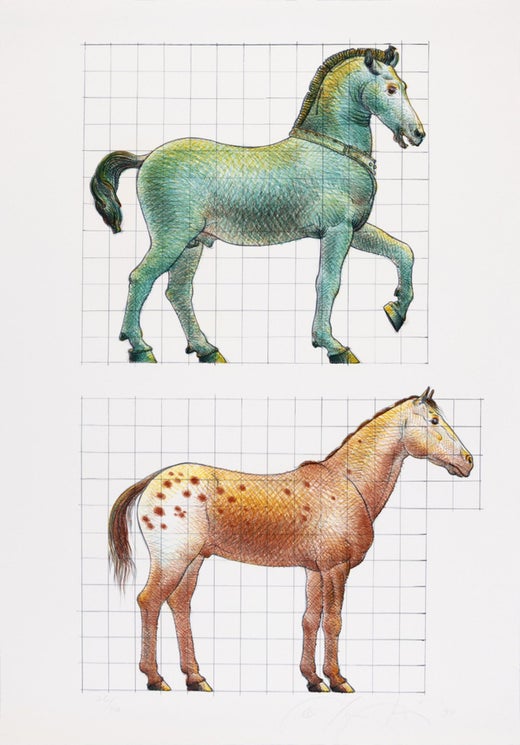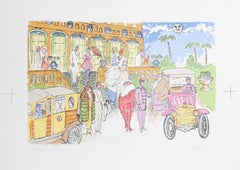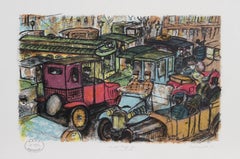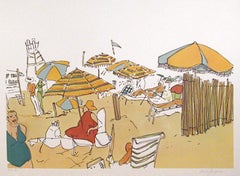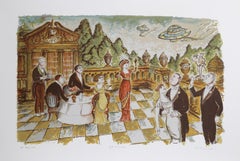Want more images or videos?
Request additional images or videos from the seller
1 of 8
Luis JiménezFiesta (Diptych)1986
1986
Price:$2,000
About the Item
- Creator:Luis Jiménez (1940-2007, American)
- Creation Year:1986
- Dimensions:Height: 34 in (86.36 cm)Width: 48 in (121.92 cm)
- Medium:
- Movement & Style:
- Period:
- Condition:
- Gallery Location:Long Island City, NY
- Reference Number:1stDibs: LU4664548231
Luis Jiménez
Born in El Paso, Texas, he worked at his father's neon sign studio as a child, which prepared him to make public art. He studied art and architecture at the University of Texas in Austin and El Paso, earning a bachelor's degree in 1964. He moved to New York City in 1966 after completing his post-graduate work at Ciudad Universitaria, Mexico City, D.F. He became an accomplished artist and taught art at the University of Arizona and later the University of Houston. As a sculptor, Jiménez was known for his large polychromed fiberglass sculptures, often of Southwestern and Hispanic themes. His works were often controversial. They are eminently recognizable due to their themes, his original sculptural style, and the colorful, undulating surfaces the artist employed. The finish of his sculptures had more in common with commercial products than with conventional fine art sculptures. Man on Fire (1969) at the Smithsonian American Art Museum in 2023 Jiménez was influenced by the murals of José Clemente Orozco and Diego Rivera. He was very much a contemporary artist whose roots were in pop art, as much as they were in both the modernism of the Mexican muralists and the regionalism of Thomas Hart Benton and Grant Wood. Heroic sculptures were Jiménez's forte, championing the common man in his work. By working in his father's shop on neon signs and sculptures, he was brought in contact with popular culture, which also included lowrider car culture. The brightly painted fiberglass bodywork, often accented with glitter, served as a particularly relevant artistic influence.[5] While he is best known as a sculptor, Jiménez also made remarkable color lithographs and color drawings in pencil, pastel, and oil stick. He made preparatory drawings for his sculptures, some of which were very large. Most of his sculptures were made of fiberglass, which were cast in a mold, after which they were painted with multiple layers of paint and coated with epoxy. One art expert has noted, "There was no surface on any Luis Jiménez sculpture that was ever any less than six different colors, each airbrushed separately adding a slightly different tone." Jiménez would also often use flake, that glittery quality often seen on lowrider cars, in his paint. In 1993, Jiménez was a recipient of the New Mexico Governor's Awards for Excellence in the Arts. In 1998 he received a Distinguished Alumni award from the University of Texas in recognition of his artwork.
About the Seller
4.9
Platinum Seller
Premium sellers with a 4.7+ rating and 24-hour response times
Established in 1979
1stDibs seller since 2014
3,164 sales on 1stDibs
Typical response time: 1 hour
Authenticity Guarantee
In the unlikely event there’s an issue with an item’s authenticity, contact us within 1 year for a full refund. DetailsMoney-Back Guarantee
If your item is not as described, is damaged in transit, or does not arrive, contact us within 7 days for a full refund. Details24-Hour Cancellation
You have a 24-hour grace period in which to reconsider your purchase, with no questions asked.Vetted Professional Sellers
Our world-class sellers must adhere to strict standards for service and quality, maintaining the integrity of our listings.Price-Match Guarantee
If you find that a seller listed the same item for a lower price elsewhere, we’ll match it.Trusted Global Delivery
Our best-in-class carrier network provides specialized shipping options worldwide, including custom delivery.You May Also Like
Leaving Home (97-301), 5 color lithograph on Rives BFK paper, Signed/N Tamarind
By DeLoss McGraw
Located in New York, NY
DeLoss McGraw
Leaving Home (97-301), 1997
Five color lithograph on tan Rives BFK paper with deckled edges
Signed and numbered 3/75 in graphite pencil on the front
17 × 24 3/25 inches...
Category
1990s Outsider Art Abstract Prints
Materials
Lithograph
Lithograph from from the Artsounds Collection, signed/n famed cult artist LGBTQ
By Thomas Lanigan-Schmidt
Located in New York, NY
Thomas Lanigan-Schmidt
Untitled, from from the Artsounds Collection, 1986
Lithograph on paper
Signed and numbered from the edition of 200 in ink on the back; also bears artist's stamped name and provenance - Art Sounds portfolio.
12 × 12 inches
Unframed
Signed and numbered from the edition of 200 in ink on the back; also bears artist's stamped name and provenance - Art Sounds portfolio.
This terrific offset lithograph print exemplifies the combination of religion and kitsch that Lanigan Schmidt is best known for. This print was created in the 1980s for the famous Artsounds portfolio, which featured prints by Marcel Duchamp, Jonathan Borofsky among others. Lanigan-Schmidt was a subject of a 2013 retrospective at PS1 MOMA and is on the faculty of the School of Visual Arts in New York.
Provenance:
Artsounds Portfolio
About Thomas Lanigan-Schmidt:
Thomas Lanigan-Schmidt is represented in the collections of the Metropolitan Museum of Art, Whitney Museum of American Art, MoMA, Brooklyn Museum, Ludwig Forum für Internationale Kunst, Ackland Art Museum, Columbus Museum of Art, and Wadsworth Atheneum Museum of Art, among others. He has exhibited extensively throughout the United States and Europe, including the 1980 and 1984 Venice Biennales, the 1991 Whitney Biennial, and the 1999 exhibition The American Century: Art and Culture, 1950-2000, Whitney Museum of American Art, New York, NY. Recent solo exhibitions include Tenemental: With Sighs Too Deep for Words, Howl! Happening, New York (2018); Thomas Lanigan-Schmidt: Mysterium Tremendum, Rockland Art Center, NY (2013); and Ecce Homo: Thomas Lanigan-Schmidt & The Art of Rebellion, Pavel Zoubok...
Category
1980s Outsider Art Figurative Prints
Materials
Lithograph
Original El Empastre Autentica Comica Banda vintage poster
Located in Spokane, WA
Original Autentica Banda Comica “El Empastre” vintage poster. Archival linen backed in A- condition, ready to frame. Printed by Mirabet in Valencia, Spain.
El Empastre, a come...
Category
1940s Folk Art Portrait Prints
Materials
Lithograph
$749 Sale Price
20% Off
H 37.5 in W 25.5 in D 0.05 in
Modernist FOLK ART Original Pencil Lithograph "GRAY DAY AT THE BEACH"
By Doris Lee
Located in New York, NY
Doris Lee
Lithograph
1964
Edition Size: 250
Image Size: 12 x 9.5 inches
Sheet Size: 16.75 x 13 inches
Reference: AAA 1532
Signed lower left
Condition: Good
Provenance: ASA
Doris Emrick Lee...
Category
1960s Folk Art Landscape Prints
Materials
Lithograph, Archival Pigment
$1,100
H 17 in W 13 in D 1 in
Descanso (Break)
By Jorge Dumas
Located in Fairlawn, OH
Signed, titled and numbered in pencil
Edition: 250 (5/250)
Signed, titled and numbered in pencil
Published by Circle Gallery Ltd.
Printer: Atelier Dumas, New York
Condition: Very good
Atelier Dumas opened in New York printing own work as well as
those of Peter Max, Agam, Romare Bearden, Dali, Erté, Peter Hurd,
Ting, Karl Appel...
Category
1970s Folk Art Figurative Prints
Materials
Lithograph
Autumn in New York by Jane Wooster Scott
By Jane Wooster Scott
Located in New York, NY
Jane Wooster Scott (American, b. 1920)
Autumn in New York, c. 20th Century
Lithograph
Sight: 15 x 12 in.
Framed: 27 3/4 x 23 3/4 x 1 in.
Signed and titled lower right in plate: Autum...
Category
20th Century Folk Art Landscape Prints
Materials
Lithograph
$700
H 27.75 in W 23.75 in D 1 in
Hand signed Folk Art Naive lithograph on Arches paper Paris Evening Cafe Scene
By Michel Delacroix
Located in Surfside, FL
size includes frame: 32.5" H x 26.5" W;
Lithograph in colors depicting an enchanted evening in Paris with a bright cafe and a church or public building on a charming Paris square. ...
Category
20th Century Folk Art Figurative Prints
Materials
Lithograph
$1,750
H 32.5 in W 26.5 in
Naive Lithograph Paris Train Station Wedding Party, Honeymoon Scene Folk Art
Located in Surfside, FL
Hand signed, limited edition on BFK Rives French art paper. I believe the title is Honeymoon.
Jan Balet (20 July 1913 in Bremen – 31 January 2009 in Estavayer le Lac, Switzerland), w...
Category
20th Century Folk Art Figurative Prints
Materials
Lithograph
Israeli Naive Art Screen Print Lithograph Jerusalem, Sanhedrin Old City Folk Art
By Gabriel Cohen
Located in Surfside, FL
Bold color lithograph, hand signed in pencil and numbered AP IX/X (artist’s proof 9/10), Jerusalem Print Workshop blind stamp lower right. On French Arches paper.
Gabriel Cohen, Sel...
Category
20th Century Folk Art Landscape Prints
Materials
Lithograph, Screen
Bubby and Zayde, Judaica Folk Art Jewish Lithograph
By Michoel Muchnik
Located in Surfside, FL
The title of the piece makes reference to the subject of the piece, in this case Bubby (Grandmother in Yiddish) and Zayde (Grandfather in Yiddish). In terms of style, it looks illustrative, cartoonist, and fairy-tale like. Edition 76/260.
Michoel Muchnik was born in Philadelphia in 1952. Muchnik received his artistic training at the Rhode Island School of Design. He later studied Jewish and Talmudic studies at the Rabbinical College of America in Morristown, New Jersey.
Michoel Muchnik's art focuses on imaginative and joyful depictions of traditional and mystical Jewish and Hasidic themes. Muchnik has exhibited his work and lectured on Hasidic art throughout the United States as well as abroad. In 1977, Muchnik was selected alongside four other Hasidic artists, including Hendel Lieberman...
Category
Late 20th Century Folk Art Figurative Prints
Materials
Lithograph
More From This Seller
View AllArrival Scene, Folk Art Lithograph by Edward M. Plunkett
Located in Long Island City, NY
Edward M. Plunkett, American (1922 - 201?) - Arrival Scene, Year: circa 1979, Medium: Lithograph, signed and dedicated in pencil, Image Size: 14 x 21.5 inches, Size: 19.5 x 26 in...
Category
1970s Folk Art Figurative Prints
Materials
Lithograph
Vampire Traffic Jam, Folk Art Lithograph by Edward M. Plunkett
Located in Long Island City, NY
Edward M. Plunkett, American (1922 - 201?) - Vampire Traffic Jam, Year: circa 1980, Medium: Lithograph, signed and numbered in pencil, Edition: AP 30, Image Size: 13 x 21 inches,...
Category
1980s Folk Art Figurative Prints
Materials
Lithograph
Untitled - Beach Scene, Folk Art Lithograph by Vasilios Janopoulos
Located in Long Island City, NY
Vasilios Janopoulos, Greek (1953 - ) - Untitled - Beach Scene, Year: circa 1979, Medium: Lithograph, signed and numbered in pencil, Edition: AP 50, Size: 23 in. x 29 in. (58.42 c...
Category
1970s Folk Art Figurative Prints
Materials
Lithograph
UFO ca. 1913, Folk Art Lithograph by Edward M. Plunkett
Located in Long Island City, NY
Edward M. Plunkett, American (1922 - 201?) - UFO ca. 1913, Year: 1981, Medium: Lithograph, signed and dedicated in pencil, Image Size: 14.5 x 23.5 inches, Size: 19.5 x 28 in. (49...
Category
1980s Folk Art Figurative Prints
Materials
Lithograph
Arrival Scene, Folk Art Lithograph by Edward M. Plunkett
Located in Long Island City, NY
Edward M. Plunkett, American (1922 - 201?) - Arrival Scene, Year: circa 1979, Medium: Lithograph, signed and numbered in pencil, Edition: AP 30, Image Size: 14 x 22 inches, Size:...
Category
1970s Folk Art Figurative Prints
Materials
Lithograph
UFO ca. 1913, Folk Art Lithograph by Edward M. Plunkett
Located in Long Island City, NY
Edward M. Plunkett, American (1922 - 201?) - UFO ca. 1913, Year: 1981, Medium: Lithograph, signed and numbered in pencil, Edition: 300, AP 30, Image Size: 14.5 x 23.5 inches, Siz...
Category
1980s Folk Art Figurative Prints
Materials
Lithograph
Recently Viewed
View AllRead More
Romare Bearden’s Humanity Infuses His Bright, Bold Art
Through collage, painting and printmaking, the artist foregrounded Black life in America in revolutionary new ways.
Chryssa’s 1962 Neon Sculpture Was Way ahead of the Art-World Curve
By working with lettering, neon and Pop imagery, Chryssa pioneered several postmodern themes at a time when most male artists detested commercial mediums.
